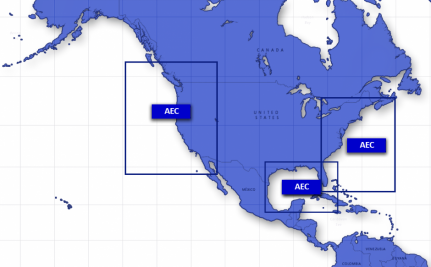Naval Research Laboratory Adaptive Ecosystem Climatology (AEC)
About

The Naval Research Laboratory Adaptive Ecosystem Climatology (AEC) integrates in situ earth observations, satellite data, and ocean model output to generate daily summaries of ocean climate conditions for the U.S. East and West Coast and the Gulf of Mexico. This dataset also combines physical oceanographic data such as current and temperature with biological data such as chlorophyll concentrations and plankton population estimates. It is a flexible eco-forecasting tool designed to inform decision-making for conservation and natural resource management.
The AEC can be used to examine mean conditions, analyze available observations, and to provide input data/boundary conditions for many types of models, including conceptual, statistical, water-quality, biogeochemical, production, mass-balance energy flow models, individual-based, and multispecies models with explicit species interaction terms, sophisticated end-to-end models, etc.
Data Access
| Product | Grid/Scale | POR | Model Cycle | Output Time Step | Access |
|---|---|---|---|---|---|
| Gulf of Mexico Model-based climatology | 1/25° | 1 year climatology | 1 day | 1 day | TDS agg, TDS files, ERDDAP 2D, ERDDAP 3D |
| Gulf of Mexico Satellite-based climatology | 1/100° | 1 year climatology | 1 day | 1 day | TDS agg, TDS files, ERDDAP |
| US East Coast Satellite-based climatology | 1/77° | 1 year climatology | 1 day | 1 day | TDS agg, TDS files, ERDDAP |
| US West Coast Satellite-based climatology | 1/78° | 1 year climatology | 1 day | 1 day | TDS agg, TDS files, ERDDAP |
Technical Specifications
The AEC incorporates three-dimensional, dynamically balanced, gridded, static climatologies for each calendar day. Using the static climatology as a background ‘first guess’, recent observations (satellite or in situ) are assimilated to adjust the climatology toward current conditions to provide updated, representative fields (adaptive climatology).
Each calendar day in the climatology represents a 5-day rolling average centered on that day, with data from all 11 years included. Thus, the value at each pixel is an average of up to 55 individual data values.
Model Based Climatology
- Description: Coupled biophysical ocean model
- Time-Frame: 33-year simulation (1980–2012)
- Resolution: 4-km
- Input Data:
- Hydrodynamics: Navy Coastal Ocean Model (NCOM) hydrodynamics
- Marine Biochemistry: Carbon Silicate Nitrogen Ecosystem (COSINE)
- Satellite SST: Advanced Very High Resolution Radiometer (AVHRR)
- Boundary Conditions:
- 1/8° Global NCOM
- Atmospheric fluxes prescribed by NASA’s Modern Era Retrospective-Analysis for Research and Applications (MERRA)
Satellite Climatology
- Variables: Chlorophyll concentration, sea surface temperature (SST)
- Time Frame: 2003-2013
- Processing Resolution: 1-km
- Input Data: Moderate Resolution Imaging Spectroradiometer (MODIS) level-1 data
File Contents
Model
- Format: netCDF
- Variables: Measured at standard depths throughout the water column
- Sea Surface Elevation
- Ocean Temperature
- Salinity
- Eastward and Northward currents
- Phytoplankton
- Diatoms
- Micro-zooplankton
- Meso-zooplankton
Satellite
- Format: netCDF
- Variables:
- Sea Surface Temperature
- Sea Surface Chlorophyll



